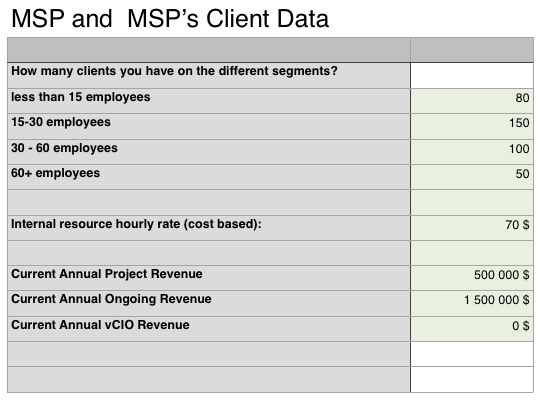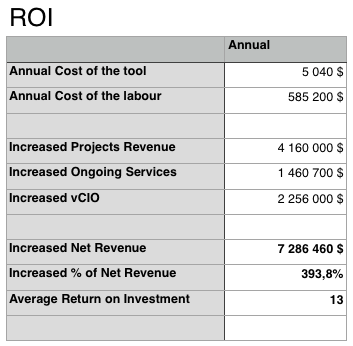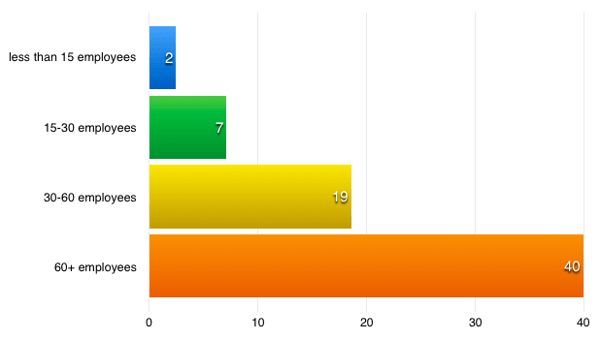
If you’re running a successful, growing and modern managed service provider practice, you either have solid account management / technical account management practice in place, or you’re still doing it ad-hoc, and plan to develop a clear structure as soon as possible. In both cases calculating the ROI of the new role is critical, as well as setting goals and realistic expectations for the employees. Check out this ROI calculation and the huge potential of proper account management to growing your business.
ROI calculation doesn’t just make visible some real numbers from something less tangible; it’s also a great way to ‘look under the hood’, to perceive what drives your success and what rules of thumb we can implement to streamline our decision process.
We’ll go through three different aspects:
- the data we need for the calculation,
- basic assumptions for the model, which you can change to suit your particular experience, market and customers,
- the formula that illustrates the potential of the role to increase revenue and return on investment.
Generate client engagement with five qbrs in 30 days
Data input
1. Client segments:
The first thing we need to know is how many clients you have under MSP contract, in each company scale.
- D: less than 15 employees ( sub $1500 MRR)
- C: 15-30 employees ($1500 - $3000 MRR)
- B: 30-60 employees (3000 - 6000 MRR)
- A: 60+ employees (6000+ MRR)
The client segments represent their buying power, and achievable up-sells / projects and additional services, as well as different life cycles and buyer's profiles.
2. account management Internal resource hourly rate
We need to understand how much time the account manager is spending on each type of accounts, to know cost of the role. The internal cost is usually the typical expense calculation: adding the salary together with all the burden and using a 70% utilization to get an annual rate. This rate typically calculates to $35 - $60 per hour.
3. Current revenue
To be able to track growth we need the current revenues from the revenue categories the account management can leverage. It’s typically the ARR (annual recurring revenue), the Project revenue and the professional services revenues like vCIO/consultation, etc.

Assumptions
For this model we assume some adoption and success rates. This will be our expectation of the account management work. It’s a very important consideration, as it sets the account manager's goals to achieve in a broader sense.
1. Adoption Rate
This is a percentage, indicating how many clients from the given customer segment will actually adopt account management. Adoption means clients actively participating in the various account management meetings, which is a direct function of how many actually see the value, invest time and develop a fruitful relationship out of it.
Typically the smaller the client is the lower the adoption rate. Their IT is not a critical part of their strategy, the budget isn’t there or we may assess that it’ll be unproductive to spend extra hours with them.
If you do account management ad- hoc, you know which clients are more tractable in this regard.
2. Additional Project Revenue Increase
A good account manager can bring more commonly implemented projects onboard. Scoping typical issues and helping close the deals are one thing. A less common practice is to sell productized projects. Creating a nice portfolio of typical projects for disaster recovery plan, security audit, application selection or any other project that can be productized and sold for a fixed fee is a huge skill you can leverage. It’s easy to sell, there’s not a lot of customization needed and it cuts down on the sales cycle, since you no longer need to plan and create proposals and customized collaterals.
We also must make assumptions of additional project revenues we can expect from the customer segment annually.
3. Additional MRR
A good account management can also sell additional MSP services, like bigger, better backups, voip, phone, print management, IT security, Managed Applications, Managed Mobile and other additional non-traditional MSP services. This will increase the MRR/user over time.
It also means that over time the client is going to be more committed, instability is less likely and our presence will grow wider with the client. This is all going to boost our profitability per client.
4. Additional Professional Services/vCIO
For each customer segment there’s a good chance to sell additional professional services. Different sizes afford different opportunities. Small clients can get professional Quarterly Planning, Annual IT Roadmaps, Training and some Project Scoping for a fixed fee, starting $250 - $500 MRR, like AM with a cool aid.
Larger clients can get budgets, project management, IT strategy plans, IT strategy execution, Application management and many other stuff for extra MRR.
The numbers given represent typical services you can sell to these customer segments with the proper education from the account management.
5. Resource requirements
Based on ouraccount management processes we perform 3x Quarterly Business Review and one Annual IT Strategy Roadmap per client. That takes about 10 hours a year per account. It does not include the quoting and additional work on the sales side. We think that is part of the profitability of the sold items, and is why we calculate 10 hours as an account management "overhead" for a client.

ROI
The ROI will calculate the investments to the tools + labour required to perform the given tasks to achieve the assumed results.
1. Cost of the tool
We include here the cost of the account management tool which is $249 per month for the functions the account management needs.
2. Cost of the labour
We just multiply the clients for whom we perform account management by the hours we need to invest at the hourly rate we calculated. As you can see that is a much bigger number. This is the account management's role cost. If you as an owner are performing this role, your expense is extremely high here.
3. Increased Revenues by segment
You can check the expected revenue increase by revenue segments. As you see it will change with your assumptions. However it is pretty clear that theaccount management role will exhibit value with the increased Projects and Additional Professional services first.

Conclusions
We can play with the numbers, but some things are obvious. Account management is a serious opportunity to grow within your established client base, but without the processes and dedicated role it will not produce consistent results. The investment is not onerous once you reach the 9-10 person company level, and past 18 it scales very smoothly. Let's check some conclusions from the ROI calculation.

1. The account management role can grow your business
Our calculation produced a 27% increase in revenue. Of course it means on January first everything is working and every client starts generating those revenues, which takes time to ramp up in the process. Allow 6 months to start generating the additional projects and service revenues. As products come together and processes get some momentum, you’ll see it take off pretty fast. You can expect results in less than 2 years from starting.
2. Doing half-assed account management is not worth the effort
"Do or do not, there is no try", said Yoda. Doing ad-hoc account management is not generating satisfactory outcomes. The investment cannot be measured, nor improved, nor managed at all. Doing something inconsistent can serve your short term revenue targets and will come across like sales campaigns. Clients will feel it. Make your decision here: there’s a chance account management is not for you and you just want to close MRRs and keep them alive.
3. Making the owner do the work is self-defeating
If the owner is the Account Manager, you’ll see dismal ROI, as the true value of your hours will be cut to a fraction. With that calculation the dream is dashed. This is a job of consistency and predictable results, and your leadership role isn’t designed to offer consistency. If you reach a client portfolio with 20-25 clients, the dedicated account management is going to be a reality. Account management activities shared with Project Management and some new sales will utilize the resources 30-50% of the time, which allows you to have somebody developing your business - current client base and new prospects as well.
4. Small clients are a burden
If you take a look at the distributed ROI, you’ll notice that the overall average is 9x, the small company average is far lower at only 3x, and for a large organization the ROI is remarkably high. That should not be a surprise, as investing the same time for different sizes of organizations logically pays better and can lead to more significant deals as well. This is economy of scale. The only reasonable path is to get the small clients to pay for account management services. You can call them "Client Advisory" services and charge $100 - $250 per month extra for doing the QBRs and the annual strategy planning as vCIO light services. This not only sets appropriate expectations and you get something back from your investments, but can also serve to qualify your clients.




